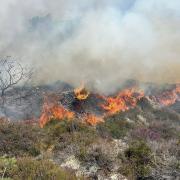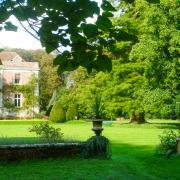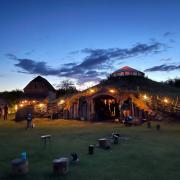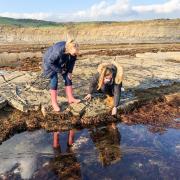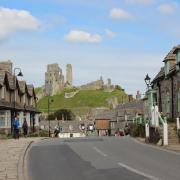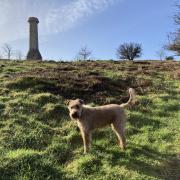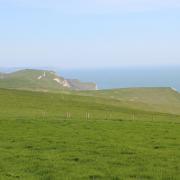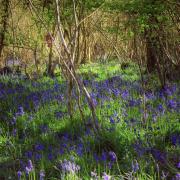If I were to tell you that I was heading out for a night-time walk in the hope of encountering a ‘crepuscular goat sucker’ or a ‘corpse-fowl’, you could be forgiven for thinking that I was going on a gothic themed ghost hunt. These are however names by which one of Dorset’s most intriguing summer visitors - the nightjar.
This unusual looking bird travels over 5000 miles each spring from its overwintering grounds in Africa. It arrives on our shores during April and May, leaving again in August for its return trip.
For centuries, the nightjar has been the subject of folklore and tall tales. As an insect feeder, it was often seen around livestock where insects gathered. Myths grew that the bird suckled from the teats of goats, hence the nickname and its Latin name, Caprimulgus Europeus, which roughly translates as ‘goat sucker’.
With its broad flat head, large eyes, and whiskery appearance, the nightjar is an unusual looking bird. Grey brown and buff coloured, its streaked and barred plumage make it exceptionally well camouflaged amongst the leaf litter where it sits quietly during the day - it can easily be mistaken for log. When it does sit in trees it lies lengthways along the branch, almost invisible against the bark.

Watch your step
The female nightjar usually lays one or two eggs directly onto the ground, its chicks are fully independent around one month after hatching. This well-camouflaged bird and its nest are incredibly easy to disturb, which is why we ask visitors to keep dogs on very short leads where dogs are allowed, and for everyone to keep to the trail paths when exploring the heathland at RSPB Arne.
Over half of England’s most threatened breeding species nest on or near the ground including nightjar, woodlark and redshank, all three of which breed at RSPB Arne. These threatened species are under increasing pressure due habitat loss, predators, and climate change. We can all help protect them from disturbance by simply following the Countryside Code and abiding by notices about ground nesting sites.
Birds like Dartford warbler and nightjar, as well as rare reptiles such as the sand lizard nest on heathland sites. These are often popular places to walk, cycle, horse ride and picnic too. By sticking to the footpaths and keeping your dog on a short lead you can help to keep nests, chicks and lizard hatchlings safe. Fire risks are also very high on tinder dry heathlands, so don’t smoke on the reserve and pack a picnic rather than a BBQ, taking any litter home.

Close encounters with a nightjar
Night-time hunting is a speciality of the nightjar, its wide mouth is very efficient at capturing moths as it flies silently over the heath. This agile flier, with its pointed wings and long tail, has a similar shape to a kestrel or a cuckoo in flight.
For me, there is nothing as magical as standing out on the heathland on a warm summer’s evening, eyes closed and simply listening to the churring sounds of these incredible birds. It is such an unusual sound, interspersed with the slapping sounds of the males ‘clapping’ their wings. You can’t mistake it.
If you want to experience this for yourself book onto our RSPB Arne Nightjar Walk and Supper with 15 dates spread over June and July. Enjoy a locally sourced, home cooked meal in the RSPB Arne café (veggie and vegan options available) at 7pm with the walk leaders and then head off at 8pm into the reserve for a magical two-hour after dark experience. Book at: bit.ly/NightjarWalk. If you prefer a daylight wildlife walk, then discover RSPB Arne’s special heathland reptiles on our morning Reptile Walks (dates throughout May, June, July and August). Book here: bit.ly/ReptileWlk.

Rarer than tropical rainforest

The heathland at RSPB Arne is a very special and increasingly rare habitat. The nature reserve covers around 550 hectares, which represents almost 1% of the lowland heath in England; it consists of a mosaic of habitats dominated by low growing plants like heather and gorse. Since 1800 we have lost some 80% of our heaths, including most of The Great Heath which once covered large areas of south-east Dorset, from Purbeck to the New Forest. After the Second World War much of our heathlands were destroyed, either by creating forestry plantations, extraction of materials for construction, or cleared for agriculture. Today only 58,000 hectares of heathland remains in England. This decline is mirrored in other countries so that now, globally, heathland is rarer than tropical rainforest. Many of these remaining heathlands are fragmented, isolated from each other by roads, housing, or other landscape types, forming impassable barriers to many different species. Happily, most of the remaining heaths are now in the hands of organisations who can protect, restore and link up these biodiverse landscapes, like RSPB Arne.
An increased awareness of the importance of heathland habitats for wildlife great and small, has led to several heathland restoration projects. These are critically important for the survival of not only the European nightjar but many other species who call the unique heathland habitats home. Follow us on social media for the latest sightings @RSPBArne

All of a flutter
Another heathland favourite of mine is the silver studded blue. This stunning little butterfly has suffered severe population decline due to the loss of its habitat over the years, although it is currently doing well at RSPB Arne.
The silver studded blue lays its eggs low down on the bare stems of their food plants, such as heather or gorse. The eggs remain over winter until they hatch around April. As odd as this may sound, this butterfly has a close relationship with ants throughout its lifecycle. The ants feed off a sugary substance that the caterpillars secrete, protecting them from predators at the same time. This relationship carries on underground as the ants continue to feed from and protect the pupae. When the adult butterfly emerges, late in June, it can be seen swarmed by ants protecting it until its wings have dried out and it can fly.
RSPB Arne is a great place to see these beautiful little blue butterflies. The adults roost communally, so if you are lucky, you might see a large group of them in the early morning as they open their wings to capture the heat of the sun. Find more at rspb.org.uk/arne
Summer Solstice Sunrise Walk
Experience the reserve at sunrise with our special Summer Solstice Sunrise Walk on 21 June. Starting at 4am, we take a brisk walk through the farm fields and heathlands of Arne in the darkness of pre-dawn, reaching the beach just before 5am to watch the sun rising over Poole harbour. Book at: bit.ly/SolsticeWlk – it’s well worth the early start!




